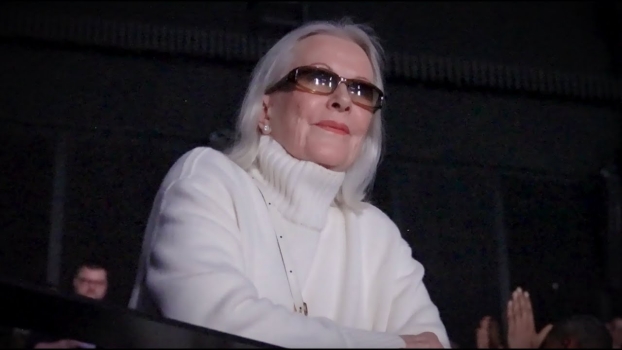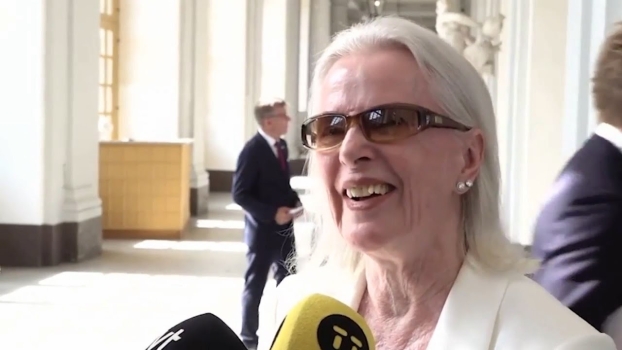
Frida was born in Bjørkåsen, a small village, near Narvik, in the north of Norway, as a result of a liaison between 19-year-old Synni Lyngstad (19 June 1926 - 28 September 1947), and a German officer, Alfred Haase (born 1919), just before the end of the Second World War and the German occupation of Norway. Her father returned to Germany when his troops were evacuated.
In early 1947, her mother, and her grandmother, Arntine Lyngstad, left her birthplace because of fear of reprisals against Lebensborn (War children) from those who had dealings with the Germans during the occupation. They would endure not just insults, but also forced separation of infants from their parents and relatives.
Frida was taken by her grandmother across the border to Sweden and eventually south to the city of Torshälla, (near Eskilstuna). Her mother stayed behind in Norway and worked for a period in the south of the country, but then became ill and travelled to Sweden to be with her mother and daughter. Synni Lyngstad died from kidney disease soon afterwards, aged 21. Frida was raised by her grandmother alone. However, close contact with her family in Norway continued, and she recalls with warmth memories of summer holidays spent with them.
Frida believed that her father had died during the war on his way back to Germany as his ship was reported to have sunk. However, in 1977, during the height of ABBA’s success, the German magazine “Bravo” published a poster and a complete biography with details of Frida's background, including the names of her father and mother. It was seen by Frida's German half-brother, who went to his father Alfred Haase and asked him if he had been in Ballangen during the war. A few months later, Frida met Haase in Stockholm for the first time.
Frida showed musical talent at an early age, beginning in her first years at school. On Fridays, she was often asked by her teacher to sing in front of the class and soon became known in school and in the neighbourhood for her beautiful voice.
In 1958, at the age of 13, she got her first job singing schlager's, with a dance band called The Evald Eks Orchestra. Mr Evald Ek himself remembers: "It was hard to believe, such a young person could sing that well. She was so easy to rehearse with and she was never shy onstage. The only thing I taught her was to sing out. In those days, she had a tendency of holding back her voice a little". With the Evald Eks Orchestra, the 13-year-old Frida, performed every weekend in front of a dancing audience. The sets often lasted up to five hours. The songs she liked most to sing were the evergreens; "All Of Me", "Night And Day" and "Begin the Beguine". At this time she also started to take singing lessons. Later, she teamed up with a 15-piece 'big band', who performed a jazz repertoire covering Glenn Miller, Duke Ellington and Count Basie; her vocal idols being Ella Fitzgerald and Peggy Lee. In 1963, she formed her own band, the Anni-Frid Four.
On 3 April 1963, aged 17, Frida married salesman and fellow musician Ragnar Fredriksson. They had two children: Hans Ragnar (born 26 January 1963) and Ann Lise-Lotte (25 February 1967 - 13 January 1998).
On September 3rd 1967, Frida won the Swedish national talent competition, "New Faces", arranged by record company EMI and held at Skansen, Stockholm. The song she chose to sing was "En Ledig Dag" ("A Day Off"). The first prize in this contest was a recording contract with EMI Sweden. Unbeknown to Frida, the winner of the contest was also expected to appear the same evening in the country's most popular TV show at that time, Hylands Hörna (Hylands corner). This happened on the same day Sweden switched from driving on the left side of the road to the right side. Driving on that day was discouraged, so most of the nation was watching TV that night. Frida performed her winning song live.
This first exposure to a wider television audience caused a sensation, and many record companies and producers contacted Frida immediately. EMI executives, fearing they might lose their new singer, took the precaution of driving from Stockholm to Frida's home in Eskilstuna the next morning with a recording contract for her to sign. EMI producer Olle Bergman remembers: "We got so interested and fond of her and I thought she had everything a person needs to become something."
On September 11th 1967, Frida recorded the vocals for "En Ledig Dag", which was to become her first single for EMI Sweden. Professional and self-assured on this first day in the studio, she recorded the vocals in just one take.
On January 10th 1968, she performed this song on national TV, and at this studio she briefly met Agnetha Fältskog, who also performed her first single in the same programme. Frida decided to move to Stockholm to start working full time as a singer. She recorded several singles for EMI. and toured Sweden in 1968.
Frida separated early in 1969 from her husband and they were officially divorced on 19 May 1970. On the very same day, Frida's grandmother, Arntine, died, aged 71
In February 1969, she participated in Melodifestivalen - the Swedish heats for the Eurovision Song Contest - with the song "Härlig är vår jord" ("Our Earth is Wonderful"), and finished fourth. Backstage she met Benny Andersson, who also participated in the contest as composer. They soon met again at another venue and then became a couple.
In February 1969, she met Benny Andersson, and the couple were engaged in August. By 1971 they were living together.
Her first album, Frida, produced by her then-fiancé Andersson, was released in 1971. The album received praise from the critics and the press, who especially noted the precision and versatility of her voice. She also had her first Swedish No.1 hit with "Min Egen Stad" ("My Own Town"). All four future members of ABBA sang back-up vocals on this song.
Anni-Frid continued to tour and play in cabarets, and regularly perform on TV and radio. Subsequently, her relationship with Benny, and friendship with Björn Ulvaeus and Agnetha Fältskog led to the formation of ABBA. In 1972, after five years at EMI Sweden, Frida changed record companies and moved to the Polar Music label. She recorded the single "Man Vill Ju Leva Lite Dessemellan", which became her second No. 1 hit on the Swedish charts.
Her next solo album in Swedish, was Frida ensam (Frida Alone), produced by Benny Andersson. By now, she was already involved in ABBA. This album includes her successful Swedish version of "Fernando", which became a huge hit in Scandinavia. In Sweden, Frida´s "Fernando" stayed at the No 1 spot on the charts for 10 weeks. The album was recorded between sessions of the ABBA albums "Waterloo" and "ABBA". Due to the rising popularity of the group, the album took 18 months to record. It became an enormous commercial and critical success in Scandinavia, topping the Swedish album charts for six weeks and remaining in the charts for 40. The album was mostly a collection of covers of songs by artists like the Beach Boys, 10cc and David Bowie, receiving positive reviews from Melody Maker: "The album portrays Frida as a very strong and emotive singer and shows the true value of the music, that if sung properly and with enough feeling it transcends all language barriers". This album was such a big success, it eventually went platinum.
At first, Frida was hesitant to perform with her boyfriend Benny, his best friend Björn Ulvaeus and his girlfriend, Agnetha Fältskog. Their first project together was the cabaret act Festfolk, which flopped in the winter of 1970–1971. The following year, 'Frida' toured on her own while the other three future ABBA members started performing together on a regular basis. Eventually, she rejoined them. Benny and Bjorn were busy producing other artists, but soon discovered the qualities of Frida and Agnetha's voices combined: ABBA came to life. With her warm mezzo-soprano voice, Frida contributed lead vocals to some of ABBA's biggest hits like "Fernando", "Money, Money, Money", "Super Trouper", "I Have a Dream", "Knowing Me, Knowing You" and shared lead vocals with Agnetha on "Mamma Mia", "Waterloo", "Dancing Queen", "S.O.S.", "The Name of the Game", Voulez-Vous", "Summer Night City" and others. She became known as 'the brunette' or 'the redhead' of the girls, always surrounded by an air of style, elegance and beauty. Frida clearly enjoyed the spotlight more than the other three members of ABBA. She was the only one of the four who truly liked to tour and to meet audience members one-on-one. She took an active part in co-designing the famed ABBA costumes for their tours and TV performances.
Benny and Frida finally “found time” to marry on October 6th 1978, during the height of ABBA's success. It was a very private and secret wedding.
After only three years of marriage, Frida and Benny separated in February 1981 and were divorced in November of the same year.
In 1982, during ABBA's last year as a working band, Frida recorded and released her first post-Abba solo album. This was also her first solo album in English. The Phil Collins-produced album was called Something's Going On, and became a big success for Frida worldwide. A much rockier sound was found on many of the songs and Phil Collins' special drum sound contributed a lot, especially on the lead single. The album sold 1.5 million copies and spawned the successful single "I Know There's Something Going On", which topped the charts in Switzerland, Belgium, Costa Rica and France, where it stayed No 1 for five weeks. The song also reached the Top five in Germany, Austria, the Netherlands, Norway and Australia amongst others. In the United States, the single reached a respectable No. 13 on the Billboard Hot 100 and No. 9 on Radio & Records. The song and its video were heavily promoted and played on MTV. This single sold 3.5 million copies worldwide and is the best selling solo record for any of the four former Abba members. The album itself received good reviews, with Billboard writing: "Abba´s auburn-haired songstress makes a bold solo project a stunning success", while Mark Coleman described the album in the third edition of Rolling Stone Album Guide as "a sharp, rock-oriented, delightfully eclectic album". William Cooper had a similar opinion in Allmusic: "Frida escapes the creative limitations of being a member of one of the world´s most popular groups on this solid and often riveting album". Swedish Television SVT documented this historical event by filming the whole recording process. The result became a one-hour TV documentary, including interviews with Frida and Phil, Björn and Benny, as well as all the musicians on the album. Due to the success of this album and its lead single, Frida was voted "Best Female Artist of the Year" 1982, by the readers of Sweden's biggest evening paper Aftonbladet, receiving the Swedish Music Award Prize Rockbjörnen.
In 1982, Frida left Sweden and moved to London.
In 1983, Frida assisted with ABBAcadabra - the Musical, and recorded one of the tracks with two different male vocalists in different languages, including Frenchman Daniel Balavoine on the track "Belle" and on the English version "Time" with B. A. Robertson. This track was a cover of "Arrival", an instrumental track from the ABBA album of the same name.
Frida's next album was the experimental Shine (1984). This album was recorded at Studios De La Grande Armée in Paris, France and produced by Steve Lillywhite, known for his work with artists like Peter Gabriel, U2, Rolling Stones and Morrissey amongst others. The young producer Lillywhite was only 25 when this album was recorded and he gave Frida a very experimental sound. He managed to create a relaxed atmosphere in the studio and that can be heard in Frida's vocals. Her voice sounds very natural and relaxed on "Shine". The album reached the Top 20 in many European countries, No. 6 in Sweden being its highest position.
In 1986 she relocated to Switzerland.
In 1987 Frida was in the choir when recording her former husband Benny Andersson's song "Klinga Mina Klockor".
Also in 1987, she recorded the single "Så Länge Vi Har Varann" ("As Long As We Have Each Other") with the Swedish pop group Ratata, one of Frida's favourites. One day singer Mauro Scocco called and said he had a song suitable for a duet. After hearing it, she accepted immediately. The song was and still is a big success in Sweden. The song was also recorded in English under the title of "As long as I have you". Frida believed so much in the song she was happy to do a video for both the Swedish and English versions.
In 1990, Frida became a member of the committee of the Swedish environmental organization Det Naturliga Steget ("The Natural Step"). The organization wanted a "famous face" to help them reach the public, and in 1991 she became chairwoman for the organization Artister För Miljö ("Artists For The Environment").
In 1992, she performed live at the Stockholm Water Festival at the Kings Castle and released the environmental charity single "Änglamark" / "Saltwater" (Sweden only, with Artister För Miljö) All the money from this single going to charity.
On 26 August 1992, Lyngstad married Prince Heinrich Ruzzo Reuß von Plauen (24 May 1950 – 29 October 1999). By this marriage, she has two stepdaughters, Princess Henriette and Princess Pauline. Through her marriage to Prince Heinrich Ruzzo, who was a student at the same boarding school as the reigning King of Sweden, she became acquainted with the Swedish royal family and eventually became close friends with Sweden's Queen Silvia.
In 1993, on Queen Silvia's 50th birthday, Frida was asked to perform "Dancing Queen" on stage, as performed by ABBA when the king and queen got married. Frida contacted The Real Group and together they performed the song live at the Stockholm Opera House in front of the king and queen. The Swedish prime minister at the time, Ingvar Carlsson, also present that night, said it was an ingenious step to do "Dancing Queen" a cappella. This event was shown on Swedish TV.
In 1996, Frida recorded her Swedish language album Djupa andetag (Deep Breaths). It was a long-awaited album as 12 years had passed since Shine was released. The album attracted overall positive reviews and was a big success in Scandinavia and went to No 1 on the album chart in Sweden. Frida did many TV appearances in Sweden, Norway, Denmark and Finland to promote the album. Djupa andetag was one of the very first Swedish albums to be released as a combined audio–video CD-ROM, including interviews with Frida, footage from the making of the album, as well as promotional videos. Despite the fact that Djupa andetag was officially only released in Scandinavia and the songs were entirely sung in Swedish, a remix album of the single tracks "Även En Blomma", "Alla Mina Bästa År" (a duet with Roxette's Marie Fredriksson) and "Ögonen" was released in Germany in 1998, entitled Frida - The Mixes, an evidence of Frida's continuing popularity in Continental Europe. A one-hour documentary about the making of this album, both in the studio and from Frida's home in Mallorca, Spain, was shown on TV in many countries. A follow-up album with producer Anders Glenmark was reportedly in the works, but was shelved due to a death in Frida's family. On January 13, 1998, Frida's daughter, Ann Lise-Lotte Casper (born Fredriksson), died of injuries sustained in a car accident in Livonia, Michigan in the United States.
Her husband, Prince Heinrich Ruzzo died of lymphoma in 1999; a year after losing her daughter.
Several one-off recordings followed, including a 2002 duet with opera singer Filippa Giordano of the "Barcarolle" from Jacques Offenbach's Les contes d'Hoffman as well as the song "The Sun Will Shine Again", written especially for her by close friend and former Deep Purple member Jon Lord, and recorded in 2004. "Barcarolle" is only available on the Japanese edition of Giordano's album Rosso Amore, and "The Sun Will Shine Again" can be found on Jon Lord's album Beyond The Notes (although a limited-promotional single had been made available). Jon Lord and Frida made several TV appearances in Germany performing the song, on shows like The Sunday Night Classics and The Golden Henne Gala. Frida also joined Lord on stage singing the song during his European autumn tour in 2004.
For the 2004 semi-final of the Eurovision Song Contest, staged in Istanbul thirty years after ABBA had won the contest in Brighton, Frida appeared in a special comedy video made for the interval act, entitled Our Last Video. Each of the four members of the group appeared briefly in cameo roles, as did, amongst others, Cher and British comedian Rik Mayall. The video was not included in the official DVD release of the Eurovision Contest, but was issued as a separate DVD release on the Universal Music label. It was billed as the first time the four had worked together since the group split in 1982 – a truth with modification. In fact, they each filmed their appearances separately.
Also in 2004, Frida appeared with Benny and Björn at London's fifth anniversary performance of Mamma Mia!, the musical based on ABBA songs.
On November 15, 2005, to celebrate Frida's 60th birthday, Polar Music /Universal Records released the Frida - Box Set, consisting of all the solo albums she recorded for Polar Music, all digitally remastered and including a set of bonus tracks. Also included is Frida - The DVD. On this 3 1/2 hour DVD Frida talks about her entire career in the music business. Filmed in the Swiss Alps and with the glorious Matterhorn mountain top in the background, a very open and relaxed Frida talks about her singing technique and about her career both before and after Abba. She explains how songs were performed and recorded and also some funny and memorable moments of the past. Thanks to the collaboration with Swedish TV, SVT, the DVD includes many rare TV clips, from her early performances. Amongst many others, her first TV performance with "En Ledig Dag", (A Day Off) is included. A one hour TV-documentary about the recording of the album Something's Going On is included, with interviews with Frida, producer Phil Collins, as well as all the musicians on the album. The same goes for the recording of her 1996 Swedish album Djupa andetag (Deep Breaths), which was also filmed during making and recording. This is also a one hour TV special, with interviews with Frida, producer Anders Glenmark. We can see the making of the video to the single "Även en blomma" (Even a flower). Frida is also filmed and interviewed in her home in Spain. Included are also all her promo videos she made for her international solo projects.
In 2005, she joined all three of her former ABBA colleagues at the Swedish premiere of Mamma Mia! at Cirkus in Stockholm. They however all arrived separately and were not seen together in public.
In 2005, she stated in an interview that she had no interest in a music career, though eighteen months later she returned to the recording studio. She currently lives in Zermatt, Switzerland.
Today, Frida still engages in charity work - environmental issues in particular.
In 2007, she became one of the initial patrons of the Zermatt Unplugged Music Festival along with Jon Lord and Claude Nobs.
In 2008 she again joined Benny and Bjorn this time in London for the world premiere of MAMMA MIA! The Movie. Then again in Stockholm for the Swedish premiere of the film, where to the surprise and joy of fans she was joined also by Agnetha. It was the first time all 4 members had been photographed together in public for 20 years.
In September 2010, a new album by musician Georg Wadenius titled Reconnection was released. Lyngstad and Wadenius had discussed working together for many years, as they had long been good friends. The album opens with her rendition of the traditional tune "Morning Has Broken", previously covered by Cat Stevens. This song is a favourite for Frida and the song was also on the playlist in the church for Frida and Prince Ruzzo's wedding on 26 August 1992.
In 2013, she helped organise the opening of ABBA The Museum in Stockholm stating she wanted to "let ABBA rest". The long-awaited ABBA reunion was expected to happen in 2014 to celebrate the 40th anniversary of the group's win at the Eurovision Song Contest. However, this did not happen.
In 2015, Frida, along with Dan Daniell, released the single "1865" about the Matterhorn in Switzerland.
On 19 August 2017,Frida travelled to Torshälla to claim her award from the Eskilstuna Music Prize 2014.
In the summer of 2017, she joined her ABBA bandmates to record two new songs, "I Still Have Faith in You" and "Don't Shut Me Down". These songs were meant to be part of an ABBA-themed TV special.
In 2018, Lyngstad and jazz trumpeter Arturo Sandoval released a duet of the ABBA song "Andante, Andante" as a single. The song is featured on Sandoval's album Ultimate Duets.

Upon her marriage to Prince Heinrich in 1992, she took on a new name and has been called Princess Anni-Frid Synni of Reuss, Countess of Plauen,shortened to Anni-Frid Reuss. Since his death in 1999 she is called Princess Anni-Frid, Dowager Countess of Plauen.
She is entitled to the courtesy style of Serene Highness.

Since the members of ABBA went their separate ways, Anni-Frid Lyngstad has been the only one who openly regreted there never was a reunion. Untill Voyage!
Excerpts taken from Wikipedia,/Carl Magnes Palm /Polar Music. Compliled and written by ABBA-official 2009


